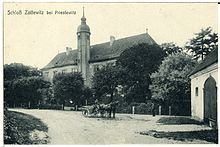Zottewitz Castle
Zottewitz Castle was a castle complex that emerged from a medieval manor in today's Priestewitz district of Zottewitz in the district of Meißen . The castle was located on a small hill in the center of the village and was demolished after the Second World War.
Building description
Zottewitz Palace was a 50 m long three-storey building with 16 windows at the front. In the middle part of the south side it had a stair tower in which a spiral staircase connected the individual floors. The main building of the castle was in the east, the western half was added later and connected to the existing wing by a uniform facade design. The building had a steep hipped roof. The upper area of the striking castle tower was adorned with a sundial. At the top there was a weather vane with a representation of a rider turned backwards on a jumping bull-like animal and the year 1637, which probably indicated the completion of the palace. A gate in the stair tower showed a cartouche with the coat of arms of the von Schleinitz family on a keystone.
The basement, which dates back to the early days of the complex and has not yet been fully explored, was the ground floor with a cross-vaulted ceiling. In addition to the utility rooms, the former courtroom was also located here. A closet and the figure of an angel holding scales indicated this use. The living rooms on the upper floors mostly had simple stucco ceilings from the beginning of the 18th century. There were also two halls, salons and chambers for the servants.
history
The castle was probably built on the site of an older manor and was first mentioned in 1277. The original facility was surrounded by an enclosure wall with four corner bastions and loopholes. The von Taubenheim family owned the castle from 1473 to 1586 . From 1597 until 1840 it belonged to the von Schleinitz noble family, which was based in the Meißner Land and spread across many branches . The building was changed and expanded several times before it was largely completed in 1673.
In the 18th and 19th centuries, the Zottewitz manor was given to various middle-class tenants. During the Second World War, parts of the Dresden art collections were relocated here.
As part of the land reform in 1946, Zottewitz Castle was expropriated. On September 9, 1947, the Soviet occupying power in eastern Germany issued SMAD Order No. 209 , which made it possible to demolish former aristocratic residences in order to obtain building material for the construction of new farms . In this context, the castle was blown up in 1948 and the entire complex was subsequently demolished.
Today there is a residential building on the grounds of the castle. Parts of the old cellars were preserved, some of which were filled with rubble. In the 1980s and 1990s, excavation work began, and other previously unknown vaults were discovered. Behind the former castle there is a small pond with a boat shed. The bronze tower bell of the castle tower is now kept in the Grossenhain District Museum.
Shrouded in legend is an existing underground connecting passage, which is said to have once led from Zottewitz to Hirschstein Castle on the other side of the Elbe.
literature
- Cornelius Gurlitt: Descriptive representation of the older architectural and art monuments of the Kingdom of Saxony , Volume 37 (Amtshauptmannschaft Grossenhain - Land), Dresden 1913

